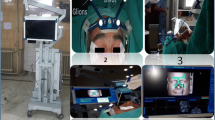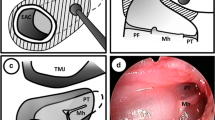Abstract
Training in functional endoscopic sinus surgery (FESS) is an essential part of each ENT resident and it takes place on a very fragile area. This study focus on showing the learning curve of FESS, using an anatomical model such as the sheep's head. Four residents in our centre performed dissections. Each of these residents operated eight sheep's head. They performed an endoscopic septoplasty followed by maxillary antrostomy, total ethmoidectomy and frontal sinusotomy on every head. A staff member guided all procedures and checked for the appropriate dissection and complications occurred. Analysis was made upon the residents’ performance of their first four septoplasties and eight nasal sides against their subsequent performance of the same. Final procedures presented better outcomes than the initial ones on every step of them. Results were measured by means of decrease of time (P < 0.0001) and complications, showing no major complications on the latest ones. Sheep's head is a suitable substitute for the cadaveric human head, to obtain the surgical skills needed for FESS procedures. Sheep's nasal cavity allows gaining dexterity and it is an easy model to obtain.


Similar content being viewed by others
References
Kinsella JB, Calhoun KH, Bradfield JJ et al (1995) Complications of endoscopic sinus surgery in a residency training program. Laryngoscope 105:1029–1032
Stammberger H, Posawetz W (1990) Functional endoscopic sinus surgery. Concept, indications and results of the Messerklinger technique. Eur Arch Otorhinolaryngol 247:63–76
Laeeq K, Lin SY, Diaz DA et al (2013) Achievement of competency in endoscopic sinus surgery of otolaryngology residents. Laryngoscope 123:2932–2934
Ogino-Nishimura E, Nakagawa T, Sakamoto T, Ito J (2012) An endoscopic endonasal surgery training model using quail eggs. Laryngoscope 122:2154–2157
Briner HR, Simmen D, Jones N et al (2007) Evaluation of an anatomic model of the paranasal sinuses for endonasal surgical training. Rhinology 45:20–23
Gardiner Q, Oluwole M, Tan L, White PS (1996) An animal model for training in endoscopic nasal and sinus surgery. J Laryngol Otol 110:425–428
Cordero A, Medina MM, Alonso A, Labatut T (2011) Stapedectomy in sheep: an animal model for surgical training. Otol Neurotol 32:742–747
Cordero A, Benítez S, Reyes P et al (2015) Ovine ear model for fully endoscopic stapedectomy training. Eur Arch Otorhinolaryngol. doi:10.1007/s00405-014-3114-3
Mladina R, Castelnuovo P, Locatelli D et al (2013) Training cerebrospinal fluid leak repair with nasoseptal flap on the lamb’s head. J Otorhinolaryngol Relat Spec 75:32–36
Awad Z, Taghi A, Sethukumar P, Tolley NS (2015) Construct validity of the ovine model in endoscopic sinus surgery training. Laryngoscope 125:539–543
Hosemann W, Draf C (2013) Danger points, complications and medico-legal aspects in endoscopic sinus surgery. Curr Top Otorhinolaryngol Head Neck Surg 12:1–61. doi:10.3205/cto000098
Celis LS, Melcón MG, Calvo FF et al (2010) Complications of endoscopic sinus surgery in a residency training program. Acta Otorrinolaringol Esp 61:345–350
Acknowledgements
We would like to thank Medtronic, especially Pilar Sobrino, for lending the equipment that allowed us to perform the dissections.
Author information
Authors and Affiliations
Corresponding author
Ethics declarations
Conflicts of interest
The authors declare no conflicts of interest to disclose.
Rights and permissions
About this article
Cite this article
Delgado-Vargas, B., Romero-Salazar, A.L., Reyes Burneo, P.M. et al. Evaluation of resident’s training for endoscopic sinus surgery using a sheep’s head. Eur Arch Otorhinolaryngol 273, 2085–2089 (2016). https://doi.org/10.1007/s00405-015-3877-1
Received:
Accepted:
Published:
Issue Date:
DOI: https://doi.org/10.1007/s00405-015-3877-1




